VIRUS UPDATE: Xàbia drops into Medium Risk for the first time since the end of June
The infection spread has dropped significantly across the Comunidad Valenciana in the past two weeks.
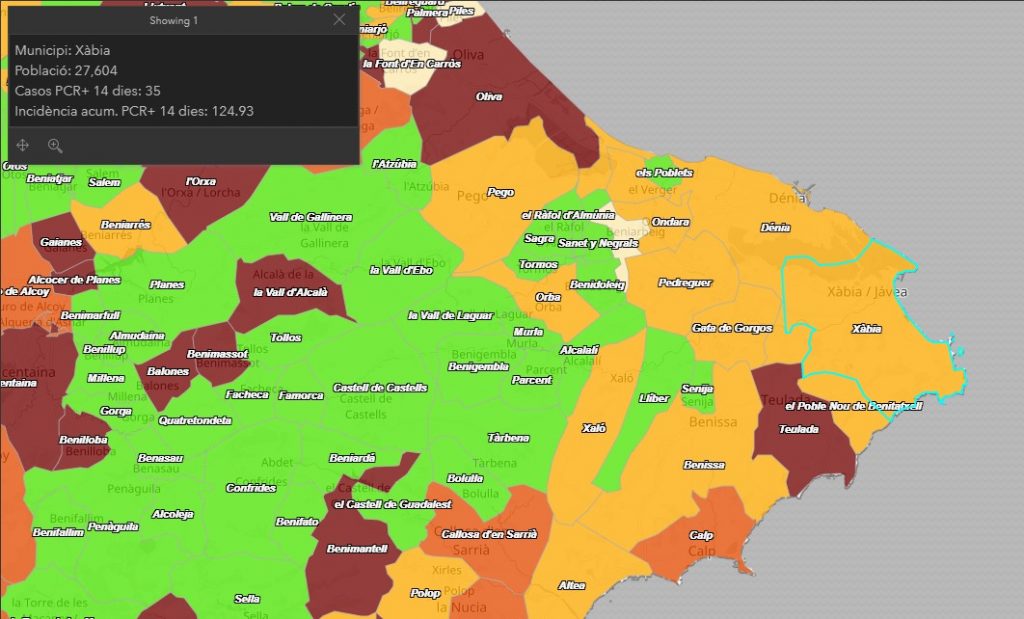
Tuesday 7th September 2021 – Compiled by MIKE SMITH
Xàbia
The total number of positive coronavirus cases detected by PCR test in Xàbia has climbed to 2,306, according to the latest update from the regional health ministry, an increase of 6 since the last update on Friday 3rd September.
The municipality’s 14-day IA rate, a measure of the speed at which the virus moves through the population, has dropped to 127.18 cases per 100,000 inhabitants and the town drops into the ‘Medium Risk’ level.
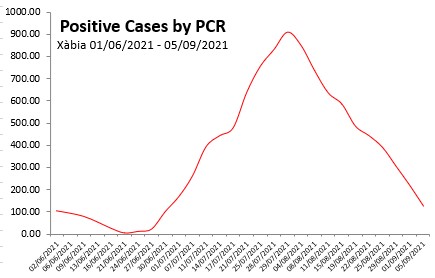
There have been no new deaths in Xàbia since late March and the number remains at 12.
Marina Alta
There have been 217 new positive cases detected by PCR test in the Marina Alta in the past 14 days and the region’s 14-day IA rate has dropped to 127.18 cases per 100,000 inhabitants and it drops into the ‘Medium Risk’ level. The detection of positive cases of COVID-19 in the region has more than halved in two weeks.
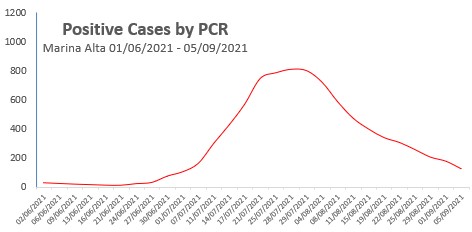
There has been 1 new death since the last update – in Calp – and the region’s toll rises to 207.
The total number of positive cases since the pandemic began is now 14,446 since the last update on Friday 3rd September, a rise of 31.
- 9 – Dénia
- 6 – Xàbia
- 3 – Benissa; Calp; Pedreguer
- 2 – Teulada-Moraira; Xaló
- 1 – El Vergel; Orba; Pego
Municipalities at EXTREME RISK level
Teulada-Moraira.
Municipalities at HIGH RISK level
Calp.
Municipalities at MEDIUM RISK level
Benissa; Dénia; El Vergel; Gata de Gorgos; Ondara; Orba; Pedreguer; Pego; el Poble Nou de Benitatxell; Xàbia; Xaló.
Municipalities at LOW RISK level
Beniarbeig.
Autonomous Regions at NEW NORMAL level
Adsubia; Alcalalí; Beniarbeig; Benidoleig; Benigembla; Benimeli; Castell de Castells; Els Poblets; Llíber; Murla; Parcent; el Ràfol d’Almúnia; Sagra; Sanet y Negrals; Senija; Tormos; la Vall d’Ebo; la Vall de Lagaur; la Vall de Gallinera.
Spain
Spain’s 14-day IA rate is 176.74 cases per 100,000 inhabitants, a drop of over 44% in the last week, and which means that the country remains the High Risk level.
The Positivity Rate, the measure of how many coronavirus tests return positive, has dropped to 6.79%. A value of 5% or less indicates that transmission of the virus is more or less under control.
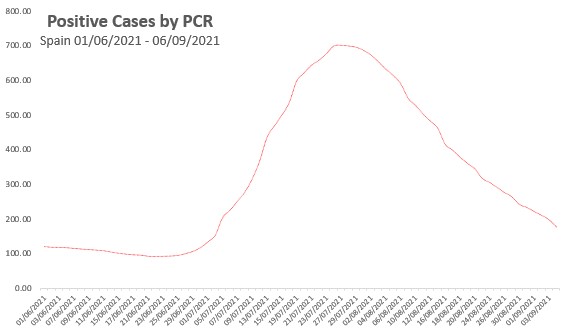
Hospitalizations
According to the latest report from the CCAES, there are 5,776 hospitalized due to COVID-19 across Spain, a drop of over 30% on two weeks ago, of which 1,382 have been admitted to ICU wards, a drop of almost 25% on two weeks ago. The percentage of beds in general wards occupied by patients suffering from COVID-19 is 4.90% whilst the percentage of beds in ICU wards occupied by COVID-19 patients is 15.15%, both lower than two weeks ago.
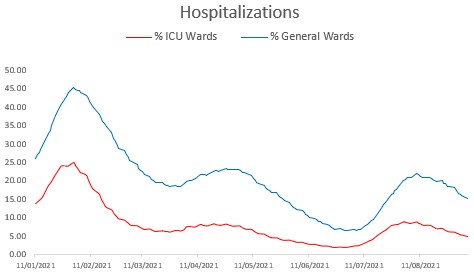
Madrid still leads the way in hospitalizations with 1,253 people currently in hospital due to COVID-19, of which 28.33% have been admitted to ICU wards for extreme cases. Cataluña is just behind, with 1,185 people in hospital, of which 27.86% are in ICU wards, whilst Andalucia has 799 people in hospital, 9.84% of which are being cared for in ICU wards.
In the Comunidad Valenciana, 337 people are currently hospitalized, according to the latest CCAES report, with 11.13% of ICU ward capacity occupied by those suffering from the extreme effects of COVID-19.
Deaths
The country has suffered 289 deaths in the past seven days, a drop of just over 4% when compared to two weeks ago. The national death toll rises to 84,928 since the pandemic began.
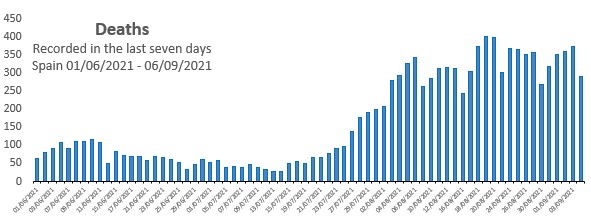
In the Comunidad Valenciana, 30 people have died from the COVID-19 disease in the past seven days, bringing the total to 7,664 since the pandemic began.
Regional Data
Across Spain, the rise of infections continues to slow with all but one of the 19 autonomous regions have reported IA rates lower than they were two weeks ago, the North African autonomous city region of Melilla (407.69) being the odd one out with a 6% increase compared to two weeks ago.
Behind Melilla, just two regions remains above 300: the autonomous city of Ceuta (349.16) and Extremadura (315.04).
At the other end of the scale is Asturias (70.28) with the Canarias on 107.72.
The Comunidad Valenciana’s rate, currently 135.98, has almost halved in the past two weeks and it remains the autonomous region with the second lowest rate in mainland Spain behind Asturias. All health departments in the region has seen positives cases drop over the past two weeks and on average, infection spread has decreased by 49% in the past fortnight.
Autonomous Regions at EXTREME RISK level
Ceuta; Extremadura; Melilla.
Autonomous Regions at HIGH RISK level
Andalucia; Aragón; Baleares; Castilla y León; Castilla-La Mancha; Cantabria; Cataluña; Galicia; La Rioja; Madrid; Murcía; Navarra; País Vasco
Autonomous Regions at MEDIUM RISK level
Asturias; Canarias; Comunidad Valenciana.
Autonomous Regions at LOW RISK level
None
Autonomous Regions at NEW NORMAL level
None
The newspaper El Pais has reported that the worst of the so-called ‘fifth wave’ of COVID-19 infections is over as the number of deaths finally begins to fall.
How does Spain compare to the rest of Europe?
Top 20 table based on daily new confirmed* COVID-19 cases per 1 million population, based on a 7-day rolling average, recorded on September 6th 2021.
- Montenegro (836.83) ↓
- Kosovo (669.28) ↓
- United Kingdom (549.43) ↑
- Serbia (501.22) ↑
- North Macedonia (316.83) ↓
- Albania (306.61) ↑
- Cyprus (270.43) ↓
- Slovenia (266.92) ↑
- Norway (263.46) ↑
- Estonia (258.94) ↓
- Lithuania (255.67) ↑
- Greece (248.75) ↓
- Liechtenstein (242.74) ↑
- Republic of Ireland (197.53) ↓
- France (188.87) ↓
- Monaco (187.97) ↑
- Bulgaria (186.86) ↓
- Belarus (182.07) ↑
- Bosnia and Herzegovina (174.35) ↑
- Latvia (170.79) ↑
Spain is in the 32nd position (121.67) ↓
↑ = infection spread trend rising
↓ = infection spread trend dropping
* The WHO defines a confirmed case is “a person with laboratory confirmation of COVID-19 infection”.
Source: ourworldindata.org
Vaccination (06.09.21)
Spain has administered 67,190,707 doses of vaccine, which is 91.2% of those which it has already received (74,470,589). A total of 34,270,593 people have completed the recommended course, which is 81.4% of the total of the population which is to be vaccinated (42,119,827) or 72.2% of the total population of Spain.
According to the latest data provided by the health authorities, 94.4% of people aged 40 and over in Spain have received at least one dose, with 92.6% having completed the recommended course.
The Comunidad Valenciana has administered 7,176,165 doses of vaccine, which is 91.3% of the total which it has received (7,860,390). A total of 3,634,067 people have completed the recommended course, which 81.0% of the population which is to be vaccinated (4,488,459) or 71.9% of the total population of the Comunidad Valenciana.
According to the latest data provided by the health authorities, 95.0% of people aged 40 and over in the Comunidad Valenciana have received at least one dose, with 93.0% having completed the recommended course.
The newspaper El Pais has reported that 75.3% of young people aged between 12 and 19 years have had at least one dose of COVID-19 vaccine, much greater than the figure to the 20-29 and 30-39 age groups (74.3% and 75.1% respectively) where progress in vaccination has slowed down. As a consequence, the Spanish Government has launched a social media campaign to encourage these groups to get vaccinated as soon as possible.
How does Spain compare to the rest of Europe?
Top 20 table based on percentage of total population fully vaccinated.
- Malta (80.42%)
- Iceland (77.01%)
- Portugal (76.85%)
- Denmark (73.06%)
- Spain (72.61%)
- San Marino (70.49%)
- Belgium (70.13%)
- Republic of Ireland (68.87%)
- United Kingdom (63.60%)
- Netherlands (62.01%)
- Italy (61.04%)
- France (60.55%)
- Germany (60.50%)
- Norway (59.36%)
- Cyprus (59.35%)
- Austria (57.98%)
- Sweden (57.89%)
- Monaco (57.07%)
- Lithuania (57.01%)
- Hungary (56.36%)
Source: ourworldindata.org
LINKS
- Actualización nº 456. Enfermedad por el coronavirus (COVID-19). 06.09.2021
- GIV COVID-19 Gestión integral de la vacunación COVID-19
- COVID-19 C. Valenciana: Monitoratge de la situació



